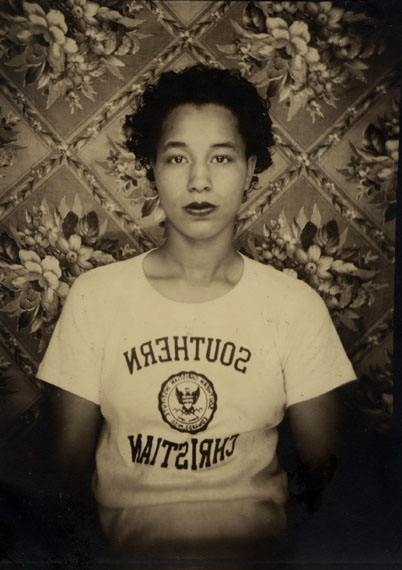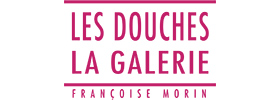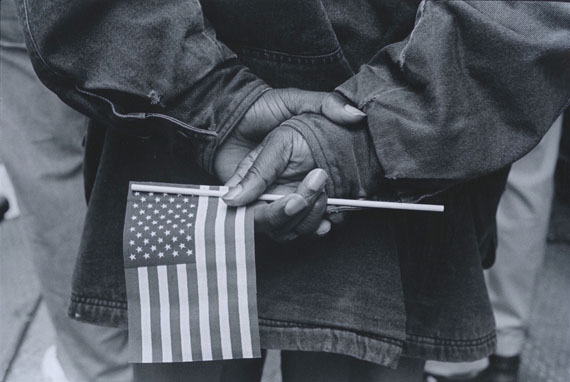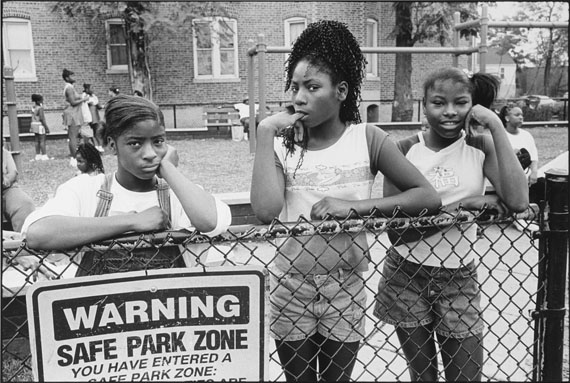
BLACK CHICAGO
Tom Arndt » Yasuhiro Ishimoto » Vivian Maier » Ray K. Metzker » Wayne F. Miller » Marvin E. Newman » Carlos Javier Ortiz »
Exhibition: 28 Oct 2017 – 13 Jan 2018

Les Douches La Galerie
5, rue Legouve
75010 Paris
+33 1-78 94 03 00
contact@lesdoucheslagalerie.com
www.lesdoucheslagalerie.com
Wed-Sat 14-19

Hands with flag, Chicago, 1990
Tirage gélatino-argentique moderne réalisé par l'artiste Image : 17,7 x 26,2 cm
Papier : 27,5 x 35,3 cm
Exemplaire N° 1/15
Titré, daté et signé par l'artiste au verso
© Tom Arndt
Courtesy Les Douches la Galerie
Black Chicago
Exhibition from October 28, 2017, to January 13, 2018
From Wednesday to Saturday, 2-7 pm and by appointment
The seven photographers who are the subject of this exhibit – Wayne Miller, Ray K. Metzker, Yasuhiro Ishimoto, Marvin E. Newman, Vivian Maier, Tom Arndt and Carlos Javier Ortiz – cover the period from 1940 to the present. None of them has followed the same path and none have the same way of looking at things. Each one presents us with a different image of the African-American community that had come to Chicago from the Deep South with the hope of greater freedom and better jobs. Their photos are a shocking and highly artistic testament to the life of the blacks of Chicago for over a half century.
Ray K. Metzker and Marvin E. Newman are all descendants of the unique talents of Laszlo Moholy Nagy. They all began their apprenticeship at the New Bauhaus, which was transplanted to Chicago in 1937 under his aegis, and followed it through the 1950s, under the direction of Harry Callahan. Through experimental and practical learning, they trained their eye to different aspects of creation: they were introduced to industrial design and advertising, followed by a specialisation in photography and its technical aspects, especially developing finesse in capturing light, geometric forms, the movement of silhouettes and tonal contrasts. But their common background is not a mark of uniformity – quite the contrary!
Ray K. Metzker chose the most geometric approach, ingeniously following Callahan’s teaching. He explores haziness, geometric forms, all the nuances of black and white, turning streets into theatre backdrops.
Coming from New York, where he gained a wide experience in short films and photography, Marvin E. Newman brought his Japanese accomplice, Yasuhiro Ishimoto, along with him on his unencumbered walks among the African-Americans of Chicago. They were the first to capture the neighbourhood where all of Chicago’s ethnic groups mixed, and where blacks came to buy modest or eccentric second-hand clothes, play blues and offer their supernatural remedies to the ill. Maxwell Street is the court of miracles that none of the other photographers was able to resist. Newman was also a regular visitor to the South Side, where from 1940 onward black poverty has only increased. He captures the delight of children. He shows us the gaze of men, looking at things we can’t see or running from things we can only imagine.
For his part, Wayne Miller never forgot either his experience during the war in the Pacific or the vision of Hiroshima. He built a careful archive of the daily life of the blacks he lived beside in his native city from 1946 to 1948. His work is like a long tracking shot through the South Side, a territory where the exuberant, public life of some alternates with the poverty of others, hidden in the dark, muddy allies.
Vivian Maier, whose singular destiny is now common knowledge, obviously needed no instruction. It was not easy for her to venture to the black South Side. But it was a resounding success! She was able to capture the slow waiting of blacks in the street; her gaze is recognizable in every photograph.
From rural Minnesota, Tom Arndt also immersed himself in black neighbourhoods. The force of his determination is particularly evident in a photo of a man looking at us as he stands in front of the simple word save. Save. One letter short of slave...
Carlos Ortiz worked in the heart of the South Side in the 2000s, when violence was as prevalent as in the past. The young victims of their own ‘brothers’ continue a culture of solidarity in suffering. Ortiz was at work day and night, offering us the devastated landscape of Englewood where every block represents a step in the incessant movement of construction and demolition, alternately resembling a battlefield and a land of solidarity.
What do these photographers feel for the people of colour who are still on the margins of other communities? They did not hide their cameras; they went out to find them in order to capture their place in the city, their attitudes and their stories.
This exhibit is part of the events of Black Chicago, which include a public conference organised by the Paris branch of the University of Chicago from 15 to 18 November 2017.
Henri Peretz
Sociologist, Université de Paris 8, Senior Fellow Yale Univertisty�

Young woman, Englewood, Chicago, 2000
Tirage gélatino-argentique moderne, réalisé par l'artiste Dimensions du tirage : 40 x 50 cm
© Tom Arndt / Courtesy Les Douches la Galerie, Paris
Black Chicago
Exposition du 28 octobre 2017 au 13 janvier 2018
Du mercredi au samedi de 14h à 19h ou sur rendez-vous
Les sept photographes présentés dans cette exposition, Wayne Miller, Ray K. Metzker, Yasuhiro Ishimoto, Marvin E. Newman, Vivian Maier, Tom Arndt et Carlos Javier Ortiz couvrent une période de la photographie qui va de 1940 à nos jours. Ils n’ont ni le même parcours ni le même regard. Chacun nous livre une image différente de cette communauté afro-américaine venue à Chicago depuis le Sud, avec l’espoir de plus de liberté et d’un travail plus digne. Ces photos sont un témoignage bouleversant et hautement artistique de la vie des Noirs de Chicago pendant plus d’un demi-siècle.
Ray K. Metzker et Marvin E. Newman ont reçu un héritage unique, celui de Laszlo Moholy Nagy. Le Nouveau Bauhaus, transplanté à Chicago en 1937 sous son égide, instaure un apprentissage de la photographie qu’ils ont suivi dans les années 1950 sous la direction de Harry Callahan. Grâce à un enseignement expérimental et pratique, ils ont formé leur œil aux divers aspects de la création : introduction au design industriel, à la publicité puis la spécialisation en photographie ses aspects technique et surtout l’agilité à capter la lumière, les formes géométriques, le mouvement des silhouettes, le contraste des tons. Mais formation commune ne veut pas dire uniformité, loin de là !
Ray K. Metzker choisit l’approche la plus géométrique, il a suivi l’enseignement de Callahan avec génie. Il explore le flou, les formes géométriques, toutes les nuances du noir et blanc, et les rues deviennent des décors de théâtre.
Marvin E. Newman, venu de Brooklyn, acquiert une large expérience du court métrage et de la photo et déambule librement avec son complice le Japonais Yasuhiro Ishimoto dans le Chicago noir. Ils sont les premiers à capturer le quartier où se mêlent toutes les ethnies de Chicago, et où les Noirs viennent acheter des vêtements modestes ou excentriques de seconde main, jouer leur blues et proposer leurs remèdes surnaturels aux malades. Maxwell Street est cette cour des miracles à laquelle n’ont pas résisté tous les autres photographes. Marvin Newman hante aussi le South Side, mais depuis les années 1940, la misère des Noirs n’a fait que croitre. Son regard se porte sur les enfants dont il saisit la joie. Il capte le regard de ces hommes dont on ne sait ce qu’ils attendent ou ce qu’ils fuient.
Wayne Miller n’a pour sa part jamais oublié son expérience pendant la guerre du Pacifique, pas plus que la vue d’Hiroshima. Il a forgé une documentation attentive de la vie quotidienne des Noirs qu’il a côtoyés dans sa ville natale de 1946 à 1948. Son œuvre est comme un long travelling à travers le South Side, un territoire où alternent la vie exubérante et publique des uns et la pauvreté des autres cachée au fond des sombres allées boueuses.
Vivian Maier, dont le destin singulier est désormais connu de tous, n’a évidemment suivi aucun enseignement. Il n’était pas aisé pour elle de s’aventurer dans le South Side noir. Mais quelle réussite ! Elle a su saisir la lente attente des Noirs dans la rue ; et son regard est reconnaissable dans chaque photographie.
Tom Arndt, venu de son Minnesota rural, s’est lui aussi immiscé dans les quartiers noirs. La force de son implication jaillit particulièrement dans cette photo où un homme nous regarde alors que s’inscrit derrière lui ce simple mot Save. Sauver. À une lettre près, slave…
Carlos Ortiz opère lui dans les années 2000 au cœur du South Side, où la violence sévit aujourd’hui comme hier. Les jeunes victimes de leur frère « de race » perpétuent cette culture de la solidarité dans la souffrance. Présent jour et nuit, il nous offre le paysage dévasté d’Englewood, où à chaque block de bâtiments présente une étape de ce mouvement incessant de construction et de démolition et constitue tantôt un champ de bataille, tantôt une terre de solidarité.
Qu’éprouvent ces photographes pour ces gens de couleur encore en marge des autres communautés ? Ils n’ont pas caché leur appareil et ont été à leur rencontre pour saisir leur place dans la ville, leurs attitudes et leurs histoires.
Cette exposition s’inscrit dans le cadre d’événements consacrés au Black Chicago, dont une conférence ouverte à tous, organisée par la branche parisienne de l’Université de Chicago du 15 au 18 novembre 2017.
Henri Peretz
Sociologue, Université de Paris 8, Senior Fellow Université de Yale�